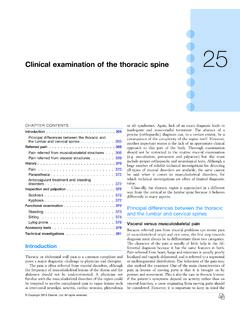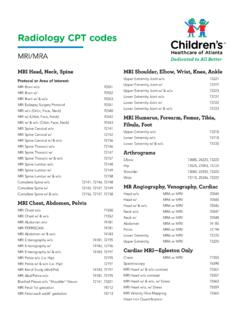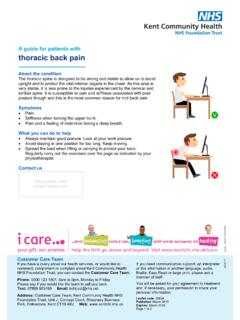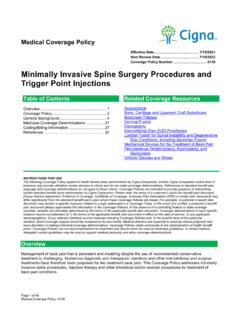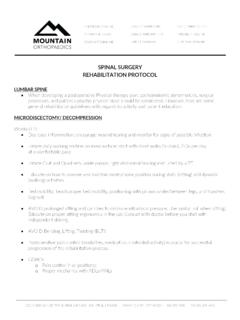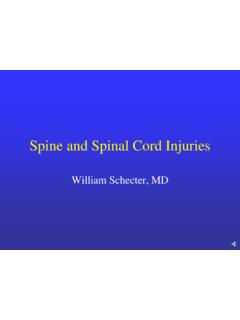Transcription of Managing Thoracic Back Pain - NHS TIMS
1 Tyneside Integrated Musculoskeletal Service Information for Thoracic Back PainIntroductionThe aims of this leaflet are to help you to understand what Thoracic back pain is and toadvise you how you can help manage your Thoracic back pain. If you have any otherquestions that are not answered by this leaflet please ask your is Thoracic back painThe Thoracic spine is the middle part of the spine that runs inbetween the neck (cervical spine ) and lower back (lumbar spine ).It includes 12 vertebra (the bones in your spine ) with ribsattaching to every vertebra, making it very stable and not asflexible as other areas of your pain is not as common as neck or low back pain, butcan be just as troublesome and back pain may come on gradually and may be related to sitting for long periods oftime or static postures, or sometimes may develop suddenly after twisting or lifting ordoing a new activity that you are not used to.
2 Symptoms can arise from sensitivity orirritation of any of the structures in the Thoracic spine (muscles, ligaments, joints, discsetc) and it is often very difficult to be accurate about the exact cause of most of pain can often last several weeks to several months and rarely require healthcare intervention early on. Keeping on top of pain control, continuing with normal dailyactivities as much as you are able and trying some self help measures is often people find their pain persists beyond these time frames, or comes and goes inepisodes over long periods of time. This is called persistent or chronic pain, and we knowthat in the vast majority of cases there is no serious cause to this Thoracic pain is not serious and will improve with time and staying active.
3 However, if you develop any of the following symptoms:- weakness in both your legs- difficulty walking, feeling unsteady, uncoordinated, legs giving way or feelingstiff- recent changes to your bladder or bowel function such as new incontinence,unable to empty your bladder fully or straining to pass urine or numbness aroundyour back passage or genitalsyou should seek medical attention you have :- a history of cancer- unexplained weight loss over the previous 3 months- your pain is constant and severe despite painkillers- you have severe pain at night preventing you from sleep- feel generally unwell, have a fever or night sweatsyou should discuss these symptoms with your Can I help myself?
4 Most Thoracic problems improve with time, but there are things that can be done to helpthis along as much as possible:Getting adequate pain control, particularly early on as it has been shown thatexcessive or uncontrolled pain in the early stages can sometimes lead to a pooreroutcome or slower appropriate sleep sleep is when our body recovers and heals. Pain ofteninterferes with the sleep cycle. Appropriate pain control can help, as well as consideringfactors such as avoiding caffeine late at night, getting sufficient activity through the day tomake you tired and avoiding napping through the day. A small firm cushion between theknees when sleeping on the side, or several firm pillows propping up the knees whenlying on the back, may ease symptomsTrying to remain active wherever possible.
5 It is well known now that avoiding activitybecause of pain or spending long periods sitting or lying appear to hinder rather than helpin the long term. Muscles, joints and nerves get their blood flow through movement soremaining active can aid recovery and help manage symptoms. Trying some exercises to keep your back moving. Movements of the back help to keepthe joints mobile and stop them from stiffening up. They also show the body thatmovement is safe, which can influence how much it will protect or create pain. There aresome exercises at the end of this leaflet that can be helpful in regaining mobility when youdevelop a back problem and they can sometimes help with short term pain relief.
6 As arule, don t do anything that causes excessive pain, but don t be frightened of it either, youmay have to accept some discomfort when you are trying to keep active and do theexercises. Relaxation/stress management techniques the more we learn about pain, the morewe realise the impact that low mood, fear and anxiety/worries can have on and uncertainty around the cause can lead to some of these emotions/feelings,which in turn can contribute to more distress and pain worsening. Understanding andrecognising this in yourself can be important and strategies such as Mindfulness orRelaxation techniques can sometimes is good for your back. Exercise has been shown to be the most important thingyou can do to manage your back pain in the long term.
7 Any form of exercise can bebeneficial in Managing your pain, for example; walking, swimming, cycling, going to thegym, yoga, pilates or tai chi, but there are many other things you can do. Exercise can beany activity that increases your heart rate so you are slightly out of breath (a good test isif you can still hold a conversation). The stronger, fitter and more flexible your body is, thebetter your spine can adapt to the normal day to day demands placed on Video Video When you exercise, your body produces more pain relieving hormones such as serotonin,endorphins and dopamines. These are your own natural painkillers. Many people withback pain feel better when they are exercising on a regular , it is important to do something that you enjoy, otherwise you are unlikely tokeep it up long term.
8 Your body will produce more of the natural hormones if you areenjoying it at the same is important to build up the level of activity gradually, so that your body gets used todoing the new activity over a period of time. You may find it useful to set yourself goals tohelp you with this. Aim to eventually exercise for between 20 30 minutes every following exercises can be useful to help maintain or improve your overall mobility aswell as the mobility of your back which can aid recovery. You may also find some of theexercises useful for helping to relieve pain in the short term. You don't have to do all of them, find the ones you feel most comfortable doingor which seem to help you the most and stick with to improve the mobilityIn sitting, place your hands across your chest and then twistround to one side and then the 5-10 spine RotationLie on your side, legs bent and spine in neutral position.
9 Armsbent beside your your top elbow, over as far as you can to rotate your midand upper back. Return to the starting 5 times on each sideThoracic spine RotationOn all fours, hands under your shoulders and knees under yourhips. spine in neutral one arm under the other armpit and then bring the armback and reach towards the : Focus on the movement from your Thoracic 5 times on each sideVideo Video Video Video Video Active Trunk Flexion/ExtensionOn your hands and knees, hands under your shoulders andknees under your and arch your back by tilting your pelvis backwards 5 - 10 your arms slide along the floor as far as possible. Push yourbottom back and down and the chest towards the floor.
10 Breatheout while doing the for 10-15secondsSit on a chair with a back rest. Support your neck with yourhands. Arch back over the top of the chair. Try to extend yourthoracic spine and not your for 5 seconds, repeat up to 5 timesExercises to strengthen the backLie face down, arms by your the muscles between your shoulder blades and pushyour chest forward. Lift your arms and upper trunk off the 3 5 - 10 Control in Four Point Kneeling, Arm LiftOn your hands and knees, hands under your shoulders andknees under your hips. spine is in neutral position. Lift one arm forward and then bring back to the starting only as high as you can control the position of your with your other : - Keep your lower back in neutral Try to keep the weight shift sideways as small as 5 times on each Video when you can lift your arm up in front with good control,progress to thisBird-dogOn your hands and knees, hands under your shoulders andknees under your hips.




